Next morning we woke up early again and joined another convoy to Luxor. We stop at Kom Ombo temple... built by the Greek ruler Ptolemy XII around 150 BC. It was very much intact and there was even colorful paint on many of the walls. We also stopped at Idfu temple, built by the same ruler. We arrived a our beautiful hotel in Luxor, with views of the Nile, did a quick change of clothes and headed to Luxor temple. It was massive and magnificent! We were there for the sunset. this is where the 'Avenue of the Sphinxes' is, leading up to the temple gates. Very cool. We ate an Italian dinner at our hotel (nice change) and crashed hard.
This morning, we saw he gigantic Temple of Karnak, built by pharaoh Rameses II (the Great). It went on for miles, it seemed. The largest columns I have ever seen. Lots of original paint, deep heiroglyphs and battle scenes of his Battle of Kadesh against the Hittites (history now shows that he may have lost this battle, but it was great propaganda for the time). Later we will sail across the Nile to see the Tombs of the Nobles, and tomorrow we see the Valley of the Kings. Then off to Mineh, Cairo, Alexandria, Siwa Oasis, Sinai and Petra, Jordan!
|
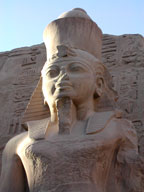 The Temple of Karnak at Luxor. This statue of Ramses II was huge.
The Temple of Karnak at Luxor. This statue of Ramses II was huge.
|
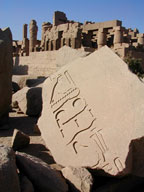 Karnak. Huge statue of Ramses and stelae of Hatshepsut in the distance. This fallen column indicates "lemonade stand for the weary."
Karnak. Huge statue of Ramses and stelae of Hatshepsut in the distance. This fallen column indicates "lemonade stand for the weary."
|
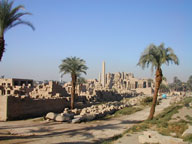 Karnak: The massive temple complex from the other side. You almost need a bike or transportation to get this far.
Karnak: The massive temple complex from the other side. You almost need a bike or transportation to get this far.
|
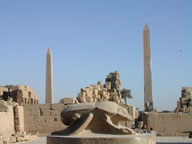 Karnak: Large scarab with two obelisks. Myth follows that those who circle around this scarab 37 times, uttering the Book of the Dead, might just find themselves reading this Book from the Other Side.
Karnak: Large scarab with two obelisks. Myth follows that those who circle around this scarab 37 times, uttering the Book of the Dead, might just find themselves reading this Book from the Other Side.
|
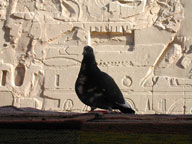 Karnak wildlife.
Karnak wildlife.
|
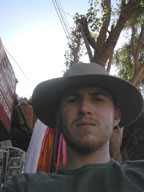 Myself, pretty ragged, halfway through the trip. Eyeing the camera with a hungry look, I suppose.
Myself, pretty ragged, halfway through the trip. Eyeing the camera with a hungry look, I suppose.
|
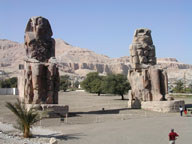
The Collossi of Ramses. These two gigantic statues have stood here for 3,600 years or more. Even the Roman emperor Hadrian visited here and "tagged" the left leg of one with graffitti.
"It's ten o'clock. Hadrian was here.
missing any sons or daughters?"
|
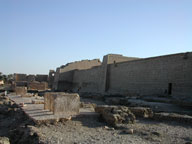
The temple of Ramses III
aka Habu Temple.
This place blew my mind. Amazingly well preserved, artifacts still strewn around the landscape.
|
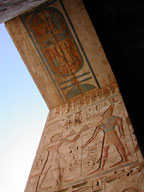 Habu Temple: Extraordinary deep relief and painted heirohlyphs. All of the paint and color is original (3,560 years old).
Habu Temple: Extraordinary deep relief and painted heirohlyphs. All of the paint and color is original (3,560 years old).
|
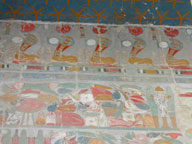 The mortuary temple of Hatshepsut. Built and painted like a tomb. Her body never made it here, and has still not been discovered.
The mortuary temple of Hatshepsut. Built and painted like a tomb. Her body never made it here, and has still not been discovered.
|
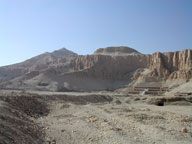 The mortuary temple of Hatshepsut from a distance. A few years back, terrorists opened fire on tourists here (mostly Japanese). All were captured. There are still bullet holes here, but I have met the honest Egyptians who put themselves in harm's way to stop the attack.
The mortuary temple of Hatshepsut from a distance. A few years back, terrorists opened fire on tourists here (mostly Japanese). All were captured. There are still bullet holes here, but I have met the honest Egyptians who put themselves in harm's way to stop the attack.
|
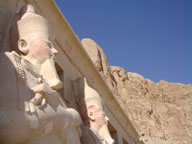 The mortuary temple of Hatshepsut.
The mortuary temple of Hatshepsut.
Massive statues of her hero (Ramses II)
|
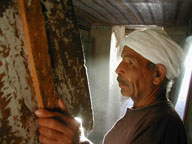 Tombs of the Nobles, just outside the Valley of the Kings). The only way light is let in is by reflection of the sun's rays... just as it was done here 3,000 years ago. This is my National Geographic shot.
Tombs of the Nobles, just outside the Valley of the Kings). The only way light is let in is by reflection of the sun's rays... just as it was done here 3,000 years ago. This is my National Geographic shot.
|
 Incredible artwork in the Tombs of the Nobles. All is original. Outstanding.
Incredible artwork in the Tombs of the Nobles. All is original. Outstanding.
|
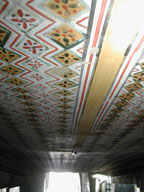 Tombs of the Nobles. Amazing, painted ceilings. I remember walking through this one. The attention to detail on the smallest aspects of the ceiling really blew me away.
Tombs of the Nobles. Amazing, painted ceilings. I remember walking through this one. The attention to detail on the smallest aspects of the ceiling really blew me away.
|
|
|
|
|
All contents (C) 2003-2017 AD. All rights reserved.
Owned, Operated, and Obsessed Upon by Gabriel Vandervort.
Reproduction without permission is prohibited.
|
|
|
|
|